五年级上册英语Unit 3 Lesson 14 May I Go to Beijing 冀教版(三起
- 格式:docx
- 大小:11.73 KB
- 文档页数:3

小学英语五年级上册 Lesson 14 May I go to Beijing 教学设计冀教版三起教学目标1.学生能够听、说、读、写本课的生词和句型:Beijing, capital, May I go to Beijing?, Yes, you may. / No, you may not.2.学生能够理解课文,并能模仿朗读。
3.学生能够用所学的词汇和句型进行交流。
4.学生能够了解中国的首都北京,并了解北京的一些特点。
教学重点1.学生能够掌握本课的生词和句型。
2.学生能够理解课文,并能模仿朗读。
教学难点1.学生能够用所学的词汇和句型进行交流。
2.学生能够了解中国的首都北京,并了解北京的一些特点。
教学过程Step 1 导入新课1.教师出示图片或视频介绍中国的首都北京。
2.教师鼓励学生谈谈他们对北京的了解。
Step 2 学习新词汇和句型1.教师出示单词卡片,学生跟读。
2.教师介绍句型“May I go to Beijing? Yes, you may./No, you may not.”,并让学生跟读。
Step 3 学习课文1.教师播放录音,学生跟读课文。
2.教师讲解课文生词和重点词汇。
Step 4 情景练习1.学生分组进行情景对话,练习句型“May I go to Beijing? Yes, you may./No, you may not.”。
2.教师巡视,辅助学生练习。
Step 5 综合练习1.教师出示图片或故事情节,让学生运用所学知识进行讨论,练习语言表达能力。
2.教师检查学生的学习效果,并提供反馈和指导。
Step 6 作业布置1.布置课后练习,巩固所学的词汇和句型。
2.鼓励学生主动了解北京和其他中国城市的特点。
教学辅助1.单词卡片。
2.录音机/播放器。
3.图片或视频素材。
教学评价1.学生能够流利朗读本课的生词和句型。
2.学生能够运用所学知识进行情景对话和讨论。
3.学生能够了解北京和中国的文化特点。
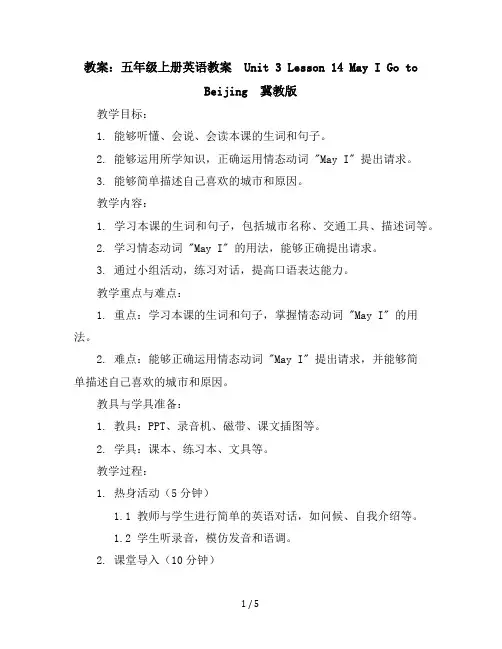
教案:五年级上册英语教案 Unit 3 Lesson 14 May I Go toBeijing 冀教版教学目标:1. 能够听懂、会说、会读本课的生词和句子。
2. 能够运用所学知识,正确运用情态动词 "May I" 提出请求。
3. 能够简单描述自己喜欢的城市和原因。
教学内容:1. 学习本课的生词和句子,包括城市名称、交通工具、描述词等。
2. 学习情态动词 "May I" 的用法,能够正确提出请求。
3. 通过小组活动,练习对话,提高口语表达能力。
教学重点与难点:1. 重点:学习本课的生词和句子,掌握情态动词 "May I" 的用法。
2. 难点:能够正确运用情态动词 "May I" 提出请求,并能够简单描述自己喜欢的城市和原因。
教具与学具准备:1. 教具:PPT、录音机、磁带、课文插图等。
2. 学具:课本、练习本、文具等。
教学过程:1. 热身活动(5分钟)1.1 教师与学生进行简单的英语对话,如问候、自我介绍等。
1.2 学生听录音,模仿发音和语调。
2. 课堂导入(10分钟)2.1 教师出示一些城市图片,引导学生谈论自己喜欢的城市。
2.2 学生听课文录音,跟读生词和句子。
3. 新课呈现(15分钟)3.1 教师出示课文插图,引导学生观察并回答问题。
3.2 教师讲解生词和句子,学生跟读并模仿。
4. 课堂练习(10分钟)4.1 学生分角色朗读课文,模仿语音语调。
4.2 学生进行小组活动,模拟对话情景,练习提出请求。
5. 课堂小结(5分钟)5.2 学生复述自己喜欢的城市和原因。
板书设计:城市名称:Beijing, Shanghai, Guangzhou, Shenzhen交通工具:train, plane, car, bus描述词:big, modern, beautiful, exciting作业设计:1. 抄写本课生词和句子,加强记忆。
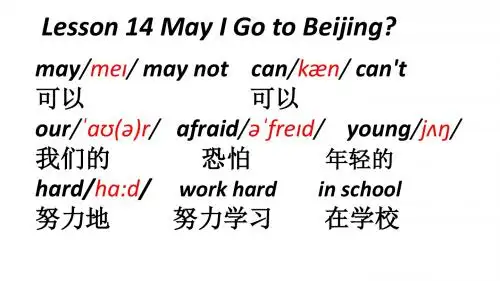
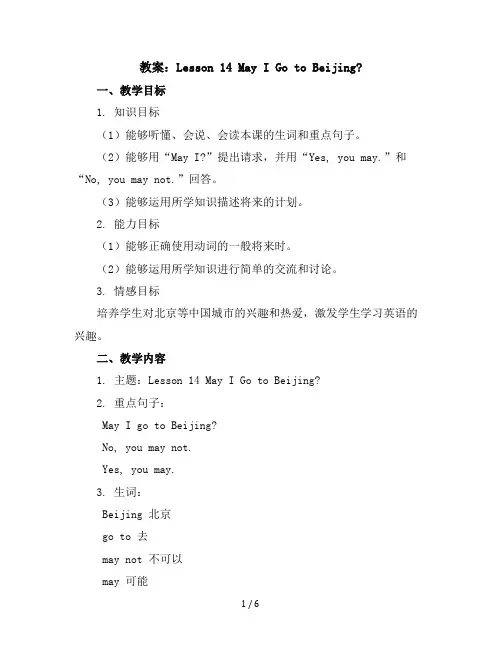
教案:Lesson 14 May I Go to Beijing?一、教学目标1. 知识目标(1)能够听懂、会说、会读本课的生词和重点句子。
(2)能够用“May I?”提出请求,并用“Yes, you may.”和“No, you may not.”回答。
(3)能够运用所学知识描述将来的计划。
2. 能力目标(1)能够正确使用动词的一般将来时。
(2)能够运用所学知识进行简单的交流和讨论。
3. 情感目标培养学生对北京等中国城市的兴趣和热爱,激发学生学习英语的兴趣。
二、教学内容1. 主题:Lesson 14 May I Go to Beijing?2. 重点句子:May I go to Beijing?No, you may not.Yes, you may.3. 生词:Beijing 北京go to 去may not 不可以may 可能No, you may not. 不可以,你有play 玩Yes, you may. 可以,你有三、教学重点与难点1. 重点:能够听懂、会说、会读本课的生词和重点句子,能够正确使用动词的一般将来时。
2. 难点:动词的一般将来时的运用。
四、教具与学具准备1. 教具:课件、黑板、粉笔2. 学具:课本、练习本、文具五、教学过程1. 导入(5分钟)通过问答的方式引导学生谈论他们将来的计划,从而引入本课的主题。
2. 展示(10分钟)(1)教师出示生词和重点句子,引导学生跟读。
(2)通过图片和情景展示,让学生理解一般将来时的用法。
3. 练习(10分钟)(1)学生分组进行角色扮演,运用所学知识进行对话。
(2)完成课本练习题,巩固所学知识。
4. 应用(5分钟)学生分成小组,讨论并制定一个未来的计划,然后向全班展示。
六、板书设计1. May I go to Beijing?3. No, you may not.4. Yes, you may.七、作业设计1. 抄写生词和重点句子。
2. 完成课后练习题。
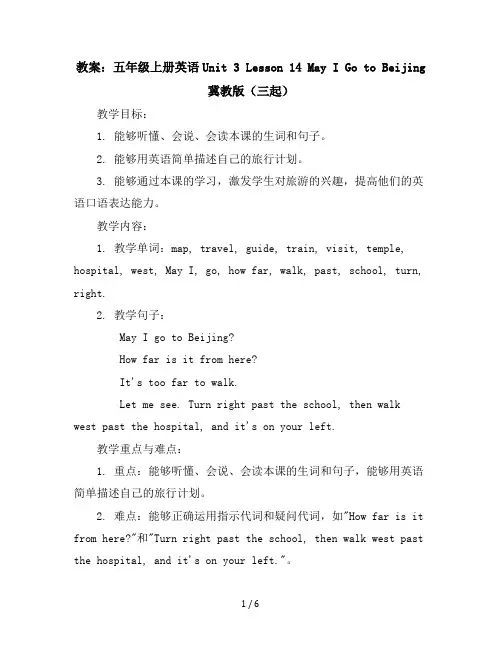
教案:五年级上册英语Unit 3 Lesson 14 May I Go to Beijing冀教版(三起)教学目标:1. 能够听懂、会说、会读本课的生词和句子。
2. 能够用英语简单描述自己的旅行计划。
3. 能够通过本课的学习,激发学生对旅游的兴趣,提高他们的英语口语表达能力。
教学内容:1. 教学单词:map, travel, guide, train, visit, temple, hospital, west, May I, go, how far, walk, past, school, turn, right.2. 教学句子:May I go to Beijing?How far is it from here?It's too far to walk.Let me see. Turn right past the school, then walk west past the hospital, and it's on your left.教学重点与难点:1. 重点:能够听懂、会说、会读本课的生词和句子,能够用英语简单描述自己的旅行计划。
2. 难点:能够正确运用指示代词和疑问代词,如"How far is it from here?"和"Turn right past the school, then walk west past the hospital, and it's on your left."。
教具与学具准备:1. 教具:地图、旅行指南、图片、录音机、课件。
2. 学具:课本、练习本、文具。
教学过程:Step 1: 热身(5分钟)1. 教师与学生用英语进行简单的问候,询问学生们的周末计划。
2. 引导学生用英语谈论他们的旅行计划,如"I'm going tovisit my grandparents."等。
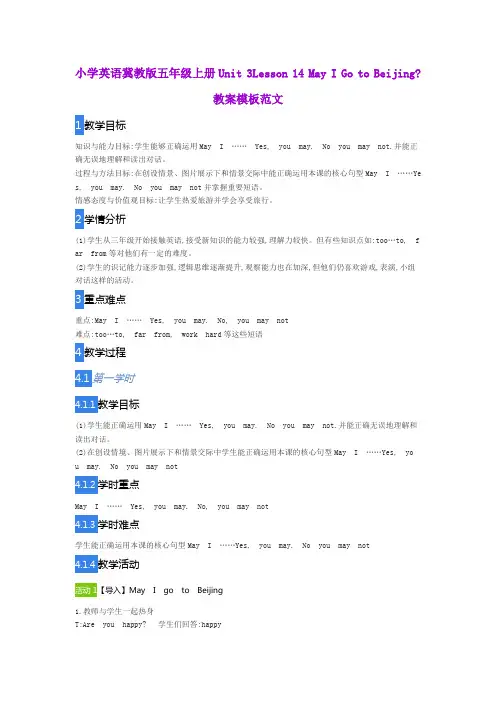
小学英语冀教版五年级上册Unit 3Lesson 14 May I Go to Beijing?教案模板范文1教学目标知识与能力目标:学生能够正确运用May I ……Yes, you may. No you may not.并能正确无误地理解和读出对话。
过程与方法目标:在创设情景、图片展示下和情景交际中能正确运用本课的核心句型May I ……Ye s, you may. No you may not并掌握重要短语。
情感态度与价值观目标:让学生热爱旅游并学会享受旅行。
2学情分析(1)学生从三年级开始接触英语,接受新知识的能力较强,理解力较快。
但有些知识点如:too…to, f ar from等对他们有一定的难度。
(2)学生的识记能力逐步加强,逻辑思维逐渐提升,观察能力也在加深,但他们仍喜欢游戏,表演,小组对话这样的活动。
3重点难点重点:May I ……Yes, you may. No, you may not难点:too…to, far from, work hard等这些短语4教学过程4.1第一学时教学目标(1)学生能正确运用May I ……Yes, you may. No you may not.并能正确无误地理解和读出对话。
(2)在创设情境、图片展示下和情景交际中学生能正确运用本课的核心句型May I ……Yes, yo u may. No you may not学时重点May I ……Yes, you may. No, you may not学时难点学生能正确运用本课的核心句型May I ……Yes, you may. No you may not 教学活动1【导入】May I go to Beijing1.教师与学生一起热身T:Are you happy? 学生们回答:happy。
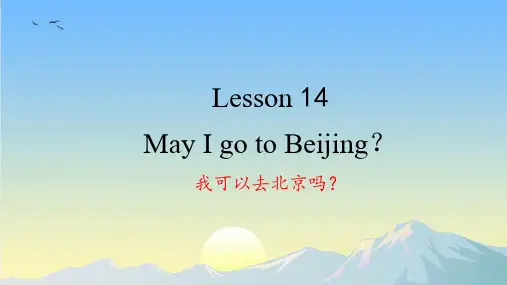
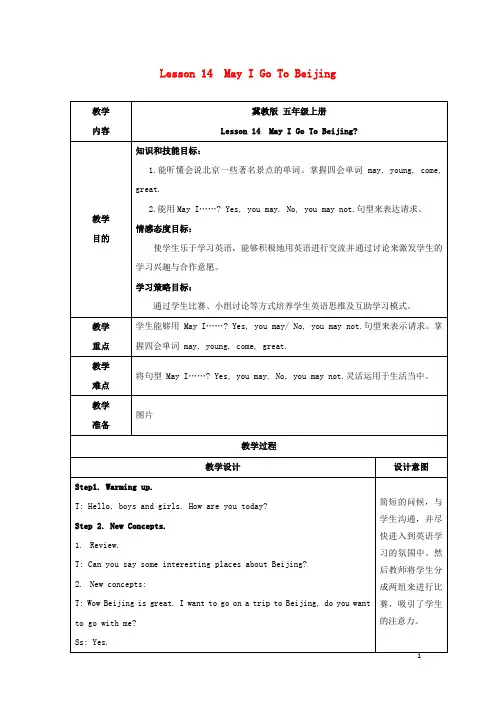
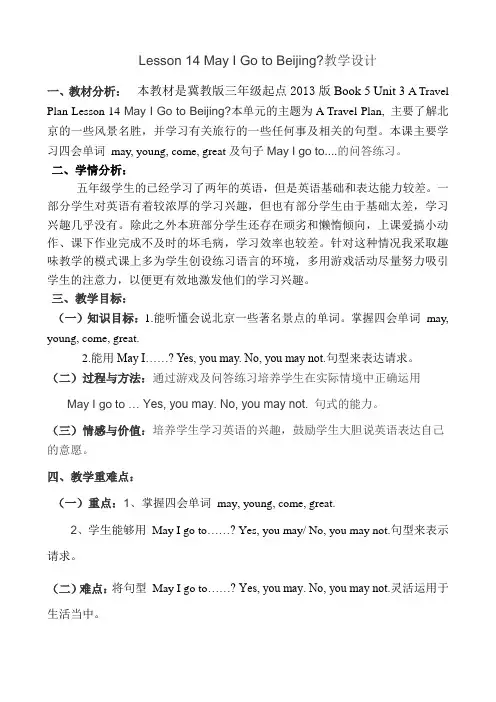
Lesson 14 May I Go to Beijing?教学设计一、教材分析:本教材是冀教版三年级起点2013版Book 5 Unit 3 A Travel Plan Lesson 14 May I Go to Beijing?本单元的主题为A Travel Plan, 主要了解北京的一些风景名胜,并学习有关旅行的一些任何事及相关的句型。
本课主要学习四会单词may, young, come, great及句子May I go to....的问答练习。
二、学情分析:五年级学生的已经学习了两年的英语,但是英语基础和表达能力较差。
一部分学生对英语有着较浓厚的学习兴趣,但也有部分学生由于基础太差,学习兴趣几乎没有。
除此之外本班部分学生还存在顽劣和懒惰倾向,上课爱搞小动作、课下作业完成不及时的坏毛病,学习效率也较差。
针对这种情况我采取趣味教学的模式课上多为学生创设练习语言的环境,多用游戏活动尽量努力吸引学生的注意力,以便更有效地激发他们的学习兴趣。
三、教学目标:(一)知识目标:1.能听懂会说北京一些著名景点的单词。
掌握四会单词may, young, come, great.2.能用May I……? Yes, you may. No, you may not.句型来表达请求。
(二)过程与方法:通过游戏及问答练习培养学生在实际情境中正确运用May I go to … Yes, you may. No, you may not. 句式的能力。
(三)情感与价值:培养学生学习英语的兴趣,鼓励学生大胆说英语表达自己的意愿。
四、教学重难点:(一)重点:1、掌握四会单词may, young, come, great.2、学生能够用May I go to……? Yes, you may/ No, you may not.句型来表示请求。
(二)难点:将句型May I go to……? Yes, you may. No, you may not.灵活运用于生活当中。

May I Go to Beijing一、教学目标1, 知识目标:掌握May I _________ ? Yes, you may. No, you may not.Words: may afraid too hard2,能力目标:培养学生在实际情境中正确运用May I _________ ? Yes, you may. No, you may not. 句式的能力。
3, 情感目标:培养学生学习英语的兴趣,鼓励学生大胆用英语表达自己的意愿。
二、学情分析学生已经有了一定的英语交流能力,实时创立教学场景,让学生大胆尝试交流,练习用英语表达自己的意愿。
三、重点难点教学重点:句子,May I _________ ?Yes, you may. No, you may not.教学难点:正确灵活运用句子,May I ___________ ? Yes, you may. / No, you may not.四、教学过程4.1 第一学时4.1.1新设计Teaching Procedures:Step I: Greetings and revision:1. Greeting.T: Hello, boys and girls.S: Hello, teacher.T: I am very cold. May I close the door?2. Revision:There are many famous places in Beijing? Do you know what they are?Play a game “guess” to review.T: At first, let’s play a game. There are many interesting places in China. I have some pictures here. I will call one student to describe the picture, the other students guess what it is.Step II: Lead in.T: They are all in Beijing. Do you want to go to Beijing? If you want to go to Beijing, what do you say with your parents?S: Can/Do/May I go to Beijing?T: But I want to use “May I …?” Because using “may”is politer.Practice to read “may”. Use the size of sound game.Step III: New concepts1. Show the picture “Watch TV”.T: Do you want to watch TV? S: Yes, I do.T: What do you say with me? S: May I watch TV?T: You are a good boy/girl. You work hard in school. I agree with you. Yes, you may. Make the students repeat.2. Show the picture “play on a computer”T: Do you want to play on a computer? S: Yes, I do.T: What do you say with me? S: May I play on a computer?T: You should work hard in school. I don’t agree with you. No, you may not. Make the students repeat.3. Show the picture “eat an apple”T: Do you want to eat an apple? S: Yes, I do.T: What do you say with me? S: May I eat an apple?T: I am afraid not. You should listen to me carefully. DO I agree or disagree with her request? I don’t agree with you. No, you may not. Make the students repeat.4.Show the word“ afraid”Play “pass and read” game. I divided the students into four groups. Let’s see who the winner is.5. Let’s go on our request.Show the pictures of “go shopping” “go to Tian’anmen Square” “go to the Great Wall” to remember how to use “May I …?” and the answers.6. Look and say.Show the sentences. Make students find how to use ‘May i…?”仔细观察句型,自己找出画横线的动词用的是什么形式?(动词原形)肯定回答: Yes, you may.否定回答: No, you may not.7. Practice.Make them to act the pictures in group.Step IV: Learn the text.1. Listen to the tape and answer the questions.T: We know Li Ming wants to travel to Beijing. Let’s see : what does he say to his mother?(课件)找出课文中May I ____________?的句子( 出示幻灯片)2. Find the different points and explain.(1)You are too young. You are young, too.区别。
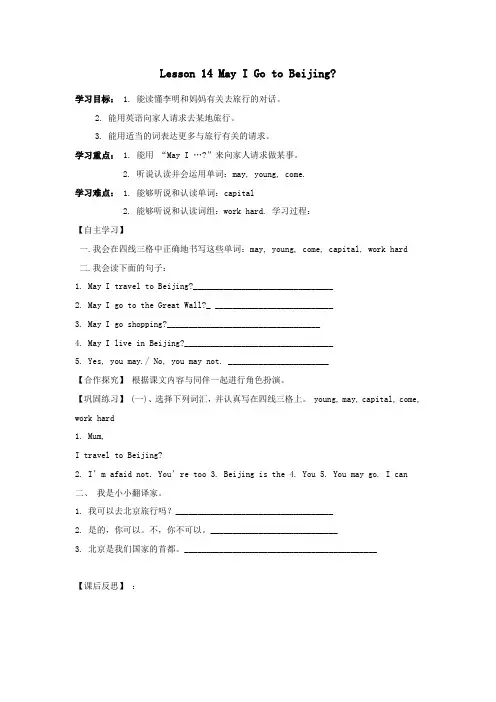
Lesson 14 May I Go to Beijing?学习目标: 1. 能读懂李明和妈妈有关去旅行的对话。
2. 能用英语向家人请求去某地旅行。
3. 能用适当的词表达更多与旅行有关的请求。
学习重点:1. 能用“May I …?”来向家人请求做某事。
2. 听说认读并会运用单词:may, young, come.学习难点: 1. 能够听说和认读单词:capital2. 能够听说和认读词组:work hard. 学习过程:【自主学习】一.我会在四线三格中正确地书写这些单词:may, young, come, capital, work hard二.我会读下面的句子:1. May I travel to Beijing?________________________________2. May I go to the Great Wall?_ ___________________________3. May I go shopping?___________________________________4. May I live in Beijing?__________________________________5. Yes, you may./ No, you may not. _______________________【合作探究】根据课文内容与同伴一起进行角色扮演。
【巩固练习】 (一)、选择下列词汇,并认真写在四线三格上。
young, may, capital, come, work hard1. Mum,I travel to Beijing?2. I’m afaid not. You’re too3. Beijing is the4. You5. You may go. I can二、我是小小翻译家。
1. 我可以去北京旅行吗?____________________________________2. 是的,你可以。
Unit 3 A Travel PlanLesson 14 May I go to Beijing?教学目标:1.知识目标:(1)能听、说、读、写单词:may, young, come, great.(2)掌握句型May I /we .......? Yes, you may. / No, you may not.2.能力目标:准确理解和掌握句型May I /we? Yes, you may. / No, you may not.3.情感目标:通过对这次北京旅行知识的学习,学生可以增加其标准英语短语和词汇的总量。
进一步激发学生学习英语的兴趣。
教学重难点:1.能听、说、读、写单词:may, young, come, great.2.掌握句型May I /we .......? Yes, you may. / No, you may not.教学准备:单词卡教学课时:2课时教学过程:第一课时Step1:Warm-up1. Greeting [激情问候,营造宽松、民主、和谐的课堂氛围]Good morning/afternoon, class! Where do we live?2. Review(1)以旧引新:指名简单介绍Beijing. 教师引入新课。
Beijing is very great. 提问:Is Li Ming going on a trip?Where is he going?(2) Li Ming want to come to Beijing,接下来他要干什么?播放课文录音。
Step 2: Presentation1. Demonstrate(1)他征求妈妈的意见时会怎样说?教师板书句型May I go on a trip to Beijing? 讲解句意(2)利用单词卡向学生演示怎样替换句型:May I…? Yes, you may. / No, you may not.(3)两人一组边指着卡片边做对话练习。
Lesson14: May I Go to Beijing教学设计学情分析:本课针对的是五年级的学生,学生已经有了四年的英语基础,能够准确得表达一些动作短语和句型,能在老师引导下,完成情境教学,和同学一起实现合作学习。
教学目标剖析:本课是五年级上学期第三单元第二课,本单元主要学习去旅行的相关的知识。
本课是承上启下的一节课,前一节课,学生已经学到了李明和妈妈计划去北京旅行。
而这一课,主要是李明和妈妈沟通去北京以及做相应的一系列事情的问答。
重点运用“May I …”句型来寻求妈妈的许可。
教学目标:1、学生在本课要学会用“May I …”句型来问答,实现在各种情境下的合理问答。
复习上单元学过的各个国家的相关内容以及四年级学过的各种活动场所和动词短语。
2、注意对学生礼仪方面的培养。
3、实现中西方文化的碰撞,激发学生的学习兴趣。
教法:问答法,启发教学,对话教学,微课教学,情境教学,故事教学。
学法说明:学生主要通过自己观看微课学习本课句型,进而主要通过同桌两两对话通过多种方法来练习。
教具:利用多媒体,ppt课件,flash ,微课教学过程:一、Play a game: Do actionsand guess.What is he/she doing?read books draw a picture sing a song sleep stand up sit down eat hamburger二、导入:Li Ming wants to travel. So he asks for his mother’s permission .Q1:Where does Li Ming want to go? Why? Play the video.Q2:What does he want to do in Beijing?Play the video again and read following one sentence by one sentence.导入微课:When we ask for permission, we should use the sentence: May I …?If you are allowed, they will say:Yes, you may. If you are refused, they will say: No, you may not. 四:Can Li Ming’s wishes e true? What does his mother say?Read freely and discuss with groups. Try to find the answers in the text.Q3:Why does Li Ming’s mother disagree with (不同意)him to travel to Beijing at first(起初)?Because Li Ming is too young. His mother thinks he is too young to go to Beijing.Q4: Why does Li Ming’s mother agree him to travel to Beijing at last?Because Li Ming is a good boy. He works hard in school. And his mother will e with him. (Who will go to Beijing with Li Ming? )Yes, it will be safe with adult. ['ædʌlt]when you want to go somewhere, you should go with your mother or father. 三、Practice.a. Do you want to travel? What country/city doyou want to go? What do you want to do? Make a dialogue with your partner.A: May I travel to______? B:Yes,you may.A:May I go to _________? B:Yes,you may, A: May I____________? B:No, you may not.b.Tell a story.1.Baby cat: Mum, may I catch the bird?Mother cat: Yes,you may.Baby cat: Mum, may I catch the butterfly? Mother cat: Yes,you may.Baby cat: Mum, I’m hungry now. May I eat your fish? Mother cat: No, you may not.2. crow: [krəʊ] Oh, I’m so thirsty. Here is a bottle of water.It’s great! But it’s so little.May I put some soil(泥土)in the bottle? Bird:No, you may not.. crow: May I put some feathers in the bottle? Bird:No, you may not.. crow: May I put some stones(石头) in the bottle? Bird:Yes,you may.crow: Haha! I can drink now.3.MonkeyA: Today I’ll find some food to eat.May I pick some peaches?MonkeyB: Yes,you may.MonkeyA: May I pick a watermelon? MonkeyB: Yes,you may.MonkeyA:May I catch the rabbit? MonkeyB: No, you may not.4. Bajie:May I eat noodles? Tangsen: Yes,you may. .Bajie:May I eat fruit? Tangsen: Yes,you may. Bajie:May I eat hamburgers? Tangsen: Yes,you may. Bajie:May I eat meat? Tangsen: No,you may not.c. Choose one letter and make a dialogue with yourpartner.At home At school At the zoo On the farm In the library On the playground In the park In the restaurant In the bedroom In the supermarket In the bathroom(浴室) A:May I _______________? B: Yes, you may. A:May I _______________? B: Yes, you may. A:May I _______________? B: No, you may not.四、Homework.Do you have a wish? What do you want to do? Whose permission will you ask for? Try to ask and write down the dialogue.教学反思:本课虽然是一节新授课,但是主要是句型为主,因此,本课主要以学习和练习句型为目的。
冀教版五年级英语上册Lesson 14 May I Go to Beijing?教学设计第一篇:冀教版五年级英语上册Lesson 14 May I Go to Beijing?教学设计冀教版五年级英语上册Lesson 14 May I Go to Beijing?教学设计馆陶县马头联校韩海进一、指导思想根据新课标的要求,本节课在设计上综合考虑了语言技能、语言知识、情感态度、学习策略几个方面的课程目标,以基本句型为重点,巩固强化动词短语,同时培养学生在公共场所应有的规矩意识。
整个教学过程以去北京旅行为背景,将句型新授和短语巩固融为一体,并以贴近生活的场景设计来提升学生的语言运用能力。
二、教材分析本课是五年级上学期第三单元第二课,本单元主要学习去旅行的相关的知识。
本课是承上启下的一节课,前一节课,学生已经学到了李明很想去北京旅行。
而这一课,主要是李明和妈妈沟通去北京以及做相应的一系列事情的问答。
要求学生能够利用目标句型提出请求并进行回答。
本课可视为语法和口语交际相结合的课程,因而既要达到口语运用目标也要明确语法要点。
三、学情分析本课针对的是五年级的学生,学生已经有了两年的英语基础,学生已经具备了一定的词汇及语言基础,能够在课堂上与教师进行对话,并能够在教师的引导下就某一话题进行探讨,这是学习本课句型的基础。
四、教学目标分析知识目标:1.学生能听懂、会说、认读并书写词汇:may ,young ,come, great2.学生能辨识、理解和运用基本句子结构:—May I…? —Yes, you may. / No, you may not.能力目标:培养学生用简单句型交流的能力,继续培养学生学习英语的兴趣。
情感目标:1.注意对学生礼仪方面的培养。
2.实现中西方文化的碰撞,激发学生的学习兴趣。
五、教学重难点学生能辨识、理解和运用基本句子结构:—May I…? —Yes, you may. / No, you may not.六、教学方法问答法、任务教学法、对话教学、情境教学。
五年级上册英语Unit 3 Lesson 14 May I Go to Beijing 冀教
版(三起)
课前导学
在本节课之前,学生已经学习了关于地理位置、交通工具等相关词汇和语句。
通过本节课的学习,将会学习并掌握如何询问去某个地方的方法并且加强学生综合能力,提高英语口语能力和阅读理解能力。
词汇掌握
在本节课中,学生需要掌握询问去某个地方的方法,同时能够描述一些常见的交通工具和地理位置。
词汇列表如下:
1.Beijing: 北京
2.Shanghai: 上海
3.Guangzhou: 广州
4.Xi’an: 西安
5.Chengdu: 成都
6.Hong Kong: 香港
7.train: 火车
8.plane: 飞机
9.bus: 公共汽车
10.subway: 地铁
11.go: 去
阅读理解
文本一
Can I help you?
Yes, please. I want to go to Beijing.
Do you want to go there by plane or by train?
I want to go by plane.
OK. Flight CA112 leaves at 12:15 p.m. and arrives at 3:00 p.m.
Thanks a lot.
You're welcome.
在这篇文本中,学生能够学到如何向别人询问去某个地方的方法以及通过询问是否去某个地方和交通工具类型来推荐合适的交通工具和班次,并且掌握表达感谢和你也可以动手帮忙的方式。
文本二
May I go to Beijing by train?
Yes, you can. What time do you want to leave?
I want to leave at 6 o'clock in the morning.
Train K47 leaves at 6 a.m. and arrives at 11:50 a.m.
How much is the ticket?
The ticket is ¥300.
Thanks. I want to book the ticket.
Let me see… yes, we still have some tickets left. What's your name?
My name is Jack.
Here is your ticket. Have a good trip.
Thank you.
在这篇文本中,学生能够学习如何向别人提出询问能否去某个地方并要求某个时间或交通工具类型的方法。
另外,学生也能够了解如何询问价格以及如何订票和领取票据,并且掌握感谢的方式。
语法讲解
在本节课中,需要重点掌握句型“May I go to…”、“Do you want to go…”和“how much is the ticket”。
具体语法如下:
1.May I go to…(我能去……吗?)
2.Do you want to go…(你要去……吗?)
3.how much is the ticket(票价多少?)
学生需要学会如何将这些语法应用于实际生活中,并且能够用正确的语法表达出自己的需求和询问。
练习
在本节课之后,学生可以通过以下两个练习来巩固所学内容。
1.Amy wants to go to Xi’an. Can you recommend a transportation for her?
2.Tom wants to go to Guangzhou by train. What time does the train leave?
总结
通过本节课的学习,学生能够掌握如何询问去某个地方的方法,并且加强了对交通工具和地理位置的认识。
同时,学生也能够运用所学语法和表达方式,提高自己的英语口语能力和阅读理解能力。